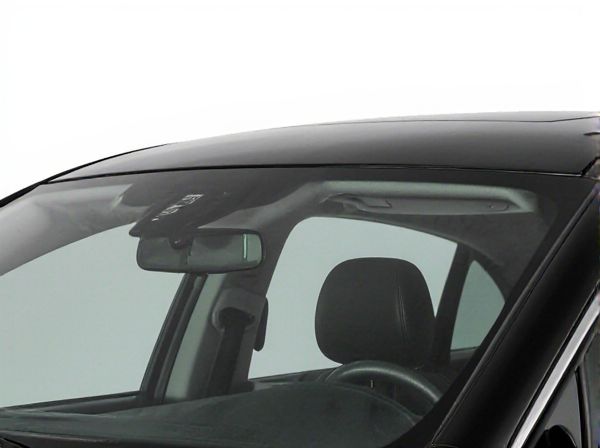
Photo illustration: Laminated vs Tempered
Tempered glass offers superior strength and safety, shattering into small, blunt pieces upon impact, while laminated glass consists of two or more layers with a plastic interlayer that holds shards together if broken. Your choice depends on the application: tempered glass is ideal for strength and thermal resistance, whereas laminated glass provides better sound insulation and enhanced security. Understanding these differences ensures you select the optimal glass for safety, durability, and performance.
Table of Comparison
| Feature | Laminated Windshield | Tempered Windshield |
|---|---|---|
| Composition | Two glass layers bonded by a plastic interlayer (PVB) | Single glass layer heat-treated to increase strength |
| Safety | Holds glass fragments in place on impact | Shatters into small, blunt pieces |
| Durability | Highly resistant to penetration and cracks | Strong but prone to shattering under high impact |
| Sound Insulation | Excellent noise reduction | Minimal noise insulation |
| UV Protection | Blocks up to 99% of UV rays | Limited UV blocking |
| Common Use | Front windshields in most vehicles | Side and rear windows |
Introduction to Laminated and Tempered Glass
Laminated glass consists of two or more layers of glass bonded together with an interlayer, usually made of polyvinyl butyral (PVB), enhancing safety and sound insulation by holding shards in place upon impact. Tempered glass undergoes a heat-treatment process to increase strength and break into small, blunt pieces rather than sharp shards, making it ideal for safety applications. Both laminated and tempered glass are widely used in automotive, architectural, and security applications due to their unique safety features and durability.
What Is Laminated Glass?
Laminated glass consists of two or more layers of glass bonded together by an interlayer, usually made of polyvinyl butyral (PVB) or ethylene-vinyl acetate (EVA), which enhances safety by holding the glass fragments in place upon impact. It offers superior sound insulation, UV protection, and structural integrity compared to standard glass, making it ideal for automotive windshields, skylights, and hurricane-resistant windows. The interlayer's ability to absorb energy reduces the risk of injury from sharp glass shards during breakage.
What Is Tempered Glass?
Tempered glass is a type of safety glass processed through controlled thermal or chemical treatments to increase its strength compared to normal glass. This process creates compressive stresses on the surface and tensile stresses inside, making tempered glass resistant to impact and thermal stress. When broken, it shatters into small, blunt fragments, reducing the risk of injury, which makes it ideal for automotive windows, shower doors, and architectural applications.
Manufacturing Processes Compared
Laminated glass manufacturing involves bonding two or more glass layers with an interlayer, typically polyvinyl butyral (PVB), under heat and pressure to enhance safety and sound insulation. Tempered glass is produced by heating annealed glass to around 620degC and then rapidly cooling it with air jets to induce surface compression, significantly increasing strength and thermal resistance. The laminated process prioritizes layered adhesion for impact absorption, while tempering focuses on thermal treatment to improve mechanical durability.
Strength and Durability Differences
Tempered glass offers superior strength by undergoing a heat treatment process that increases its resistance to impact and thermal stress compared to laminated glass. Laminated glass consists of two or more glass layers bonded with an interlayer, providing enhanced durability by holding shards together upon breakage, which reduces the risk of injury. While tempered glass is stronger in terms of resisting impact, laminated glass excels in safety and post-breakage integrity.
Safety Features: Laminated vs Tempered
Laminated glass consists of two or more layers of glass bonded with an interlayer, enhancing safety by holding shards together upon impact and preventing injury. Tempered glass undergoes a heat treatment process that increases strength and causes it to break into small, blunt pieces, reducing the risk of severe cuts. Both types improve safety but laminated glass offers superior protection against penetration and is often used in automotive windshields and security windows.
Sound Insulation and UV Protection
Laminated glass excels in sound insulation due to its interlayer that dampens noise vibrations, making it ideal for environments requiring quietness. Tempered glass, while stronger and safer upon breakage, offers limited soundproofing capabilities compared to laminated glass. Both laminated and tempered glass provide UV protection, but laminated glass filters up to 99% of harmful UV rays, significantly reducing interior fading and skin exposure.
Common Applications in Architecture and Automotive
Laminated glass is commonly used in automotive windshields and architectural windows for enhanced safety and sound insulation, as it holds together when shattered. Tempered glass is favored for side and rear automotive windows and building facades due to its high strength and ability to break into small, less dangerous pieces. Both types improve building safety codes compliance and vehicle occupant protection but serve different functional and structural requirements in design.
Cost Considerations: Laminated vs Tempered Glass
Laminated glass typically incurs higher costs due to its multi-layered construction involving interlayers, enhancing safety and sound insulation. Tempered glass offers a more cost-effective option, as it undergoes a simpler heat-treatment process to increase strength and durability. Choosing between laminated and tempered glass depends on budget constraints and the specific safety or performance requirements of the project.
Choosing the Right Glass: Key Takeaways
Choosing the right glass involves understanding key differences between laminated and tempered glass: laminated glass offers superior safety with a plastic interlayer that holds shards together upon impact, making it ideal for areas requiring enhanced security and sound insulation. Tempered glass, known for its strength and durability, shatters into small, blunt pieces, reducing injury risk and is preferred for structural applications like doors and windows. Consider factors such as safety needs, impact resistance, and application environment when selecting between laminated and tempered glass.
 caratoz.com
caratoz.com